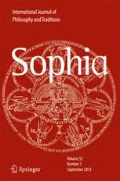Abstract
The nature of mystical experience has been hotly debated. Essentialists divide into two camps: 1) immediate identity beyond any subject-object structure 2) the mystical object maintaining some distinctness at the point of contact. Paul Tillich’s mystical a priori has some affinities with the former, while William James’ model of religious experience coheres only with the latter. Opposing the essentialists are constructivists. After noting some ironies of the constructivist position, this article elaborates difficulties with 1) the traditional model of pure identity with the divine by certain mystics, 2) the Tillichian universal mystical awareness, and 3) the Jamesian direct perceptual model. Finally, it proposes that the human body and brain mediate mystical experience, which consists of a distinctive sense of bodily harmony conjoined with openness to the potentialities of an integrated environment, involving distinctive neurological processes.
Similar content being viewed by others
Notes
This does not mean that religious symbols are arbitrary for the individual believer. Rather that, in principle, any portion of finite reality can become revelatory or symbolic depending on particular circumstances.
Unwittingly, some radical postmodernists or poststructuralists end up reinscribing the error of the incidental nature of these human mediators through an unbridled constructivism, though now there is no external object to reach (see Nikkel 2010:13–19, 31–36, 81–82).
References
Adam, M. T. (2002). A post-Kantian perspective on recent debates about mystical experience. Journal of the American Academy of Religion, 70(4), 801–841.
Barnard, G. W. (1992). Explaining the unexplainable: Wayne Proudfoot’s Religious Experience. Journal of the American Academy of Religion, 60(2), 231–256.
Brainard, F. S. (1996). Defining ‘mystical experience’. Journal of the American Academy of Religion, 64(2), 359–393.
d’Aquili, E., & Newberg, A. B. (1999). The mystical mind: Probing the biology of religious experience. Minneapolis: Fortress Press.
Damasio, A. (1994). Descartes’ error: Emotion, reason, and the human brain. New York: G. P. Putnam’s Sons.
Dean, W. (2003). A Neglected Apology for Mystery. Paper presented to the American Academy of Religion Annual Meeting, Atlanta, GA.
Eccles, J. (1989). Evolution of the brain: Creation of the self. New York: Routledge.
Edelman, G. (1992). Bright air, brilliant fire: On the matter of the mind. New York: Harper Collins.
Forman, R. K. C. (1993). Mystical knowledge: Knowledge by identity. Journal of the American Academy of Religion, 61(4), 705–738.
Glucklich, A. (2001). Sacred pain: Hurting the body for the sake of the soul. New York: Oxford University Press.
Hamer, D. (2004). The God gene: How faith is hardwired into our genes. New York: Doubleday.
Hollywood, A. (2002). Sensible ecstasy: Mysticism, sexual difference, and the demands of history. Chicago: University of Chicago Press.
Horgan, J. (2006). The God experiments. Discover, 27/12.
Idel, M., & McGinn, B. (1989). Mystical union and monotheistic faith: An ecumenical dialogue. New York: Macmillan. Editors and contributors.
Izutsu, T. (1983). Sufism and Taoism: A comparative study of key philosophical concepts. Berkeley: University of California Press.
James, W. (1890). The principles of psychology. New York: Dover. 2 vols.
James, W. (1902). The varieties of religious experience. New York: Longmans, Green, & Co.
James, W. (2003). Essays in Radical Empiricism. New York: Dover Books.
Kaplan, S. (2009). Grasping at ontological straws: Overcoming reductionism in the Advaita Vedant—neuroscience dialogue. Journal of the American Academy of Religion, 77(2), 238–274.
Katz, S. T. (1978). Mysticism and philosophical analysis. New York: Oxford University Press. Editor and contributor.
Kripal, J. (2001). Roads of excess, palaces of wisdom: Eroticism and reflexivity in the study of mysticism. Chicago: University of Chicago Press.
Monastersky, R. (2006). What happens to your brain while praying? Chronicle of Higher Education, 26, A17.
Newberg, A. (2001). Brain science and the biology of belief. Global Spiral 1 (December 10).
Newberg, A. (2006). Field analysis of the neuroscientific study of religious and spiritual phenomena. Global Spiral 6 (April 7).
Nikkel, D. (2006). The mystical formation of Paul Tillich. Global Spiral 6 (December 5).
Nikkel, D. (2010). Radical embodiment. Eugene, OR: Wipf & Stock.
Penner, H. H. (1989). The encyclopedia of religion. Critical Review of Books in Religion (pp. 1–21). Atlanta: Scholars Press.
Proudfoot, W. (1985). Religious experience. Berkeley: University of California Press.
Sells, M. (1994). Mystical languages of unsaying. Chicago: University of Chicago Press.
Shear, J. (1994). On mystical experiences as support for the perennial philosophy. Journal of the American Academy of Religion, 62(2), 319–342.
Short, L. (1995). Mysticism, mediation, and the non-linguistic. Journal of the American Academy of Religion, 63(4), 659–675.
Simoni-Wastila, H. Unio Mystica and Particularity: Can Individuals Merge 2000 with the One. Journal of the American Academy of Religion, 68/4, 857–878.
Stace, W. T. (1960). Mysticism and philosophy. London: Macmillan.
Tillich, P. (1951). Systematic theology (Vol. 1). Chicago: University of Chicago Press.
Tillich, P. (1957). Dynamics of faith. New York: Harper & Row.
Tillich, P. (1959). In R. C. Kimball (Ed.), Theology of culture. New York: Oxford University Press.
Winkelman, M. (2004). Shamanism as the original neurotheology. Zygon: Journal of Religion and Science, 39(1), 193–217.
Author information
Authors and Affiliations
Corresponding author
Rights and permissions
About this article
Cite this article
Nikkel, D. Negotiating the Nature of Mystical Experience, Guided by James and Tillich. SOPHIA 49, 375–392 (2010). https://doi.org/10.1007/s11841-010-0191-7
Published:
Issue Date:
DOI: https://doi.org/10.1007/s11841-010-0191-7
Keywords
- Mystical experience
- William James
- Paul Tillich
- Journal of the American Academy of Religion
- Essentialism
- Forman
- Shear
- Stace
- Simoni-Wastila
- Transcendence of subject-object structure
- Advaita
- Mediation
- Bracketing question of a common core
- Constructivism
- Katz
- Adam
- Brainard
- Kaplan
- Brain functioning
- Newberg
- Damasio
- Edelman
- Sense of self
- Body
- Mystical a priori
- Perception
- Short




